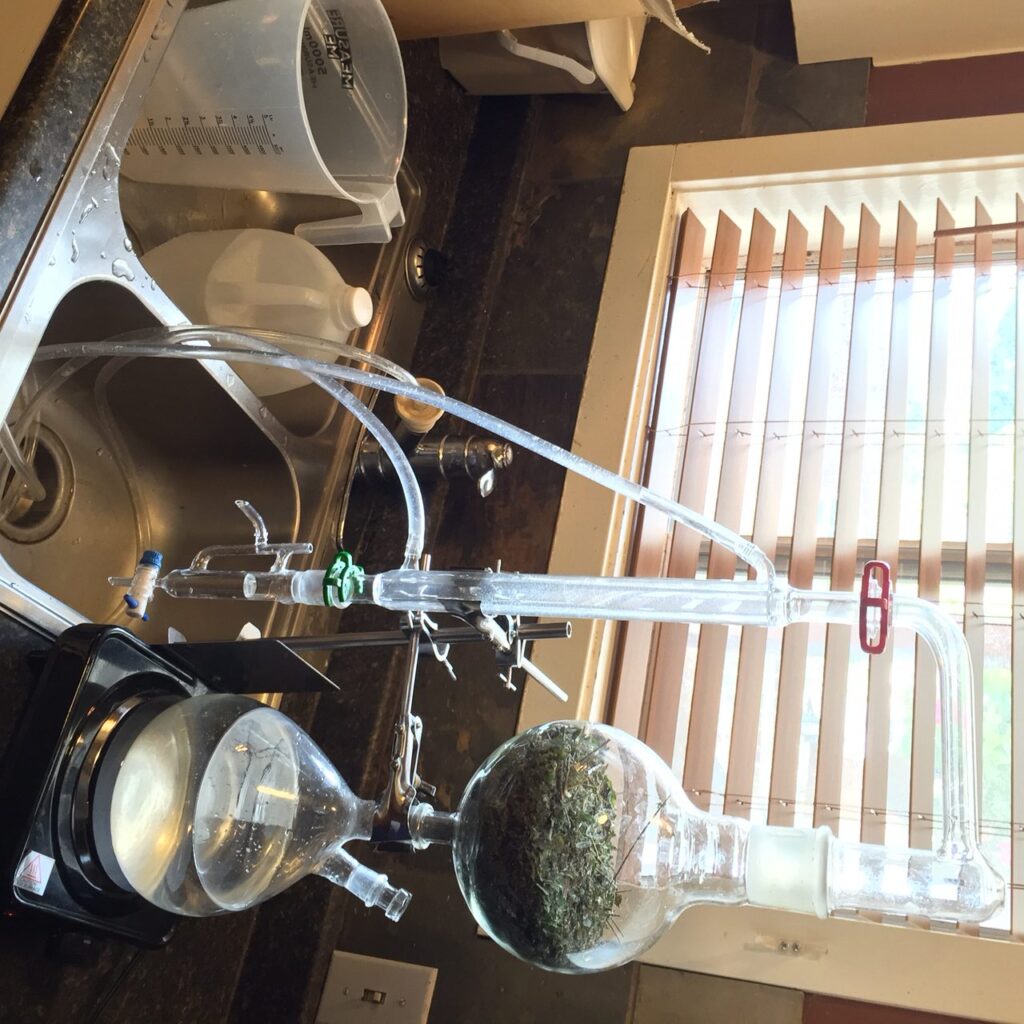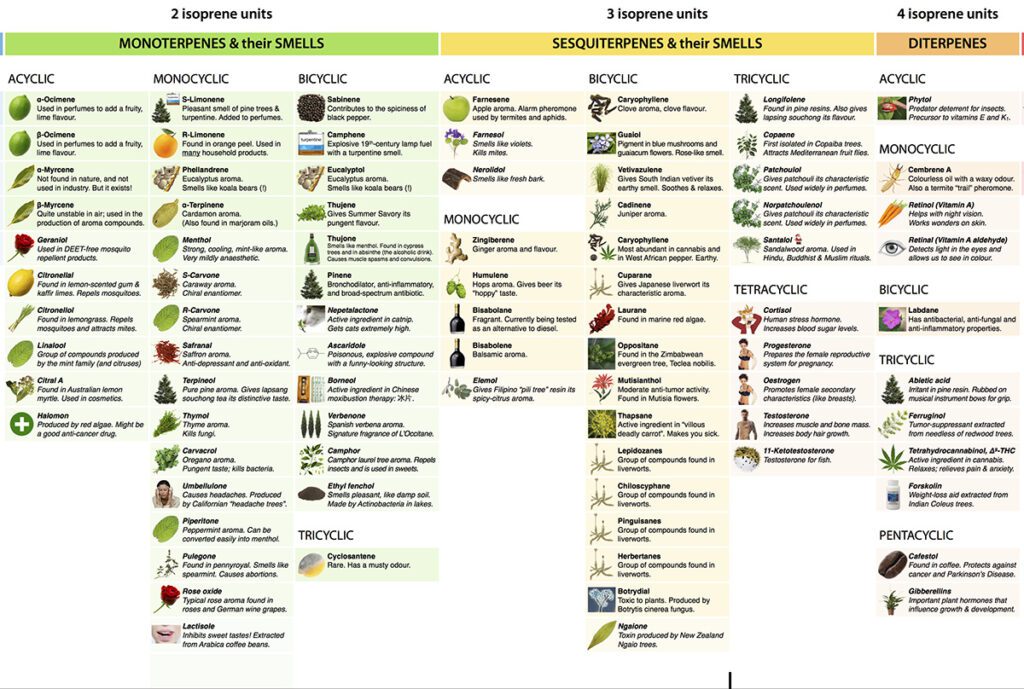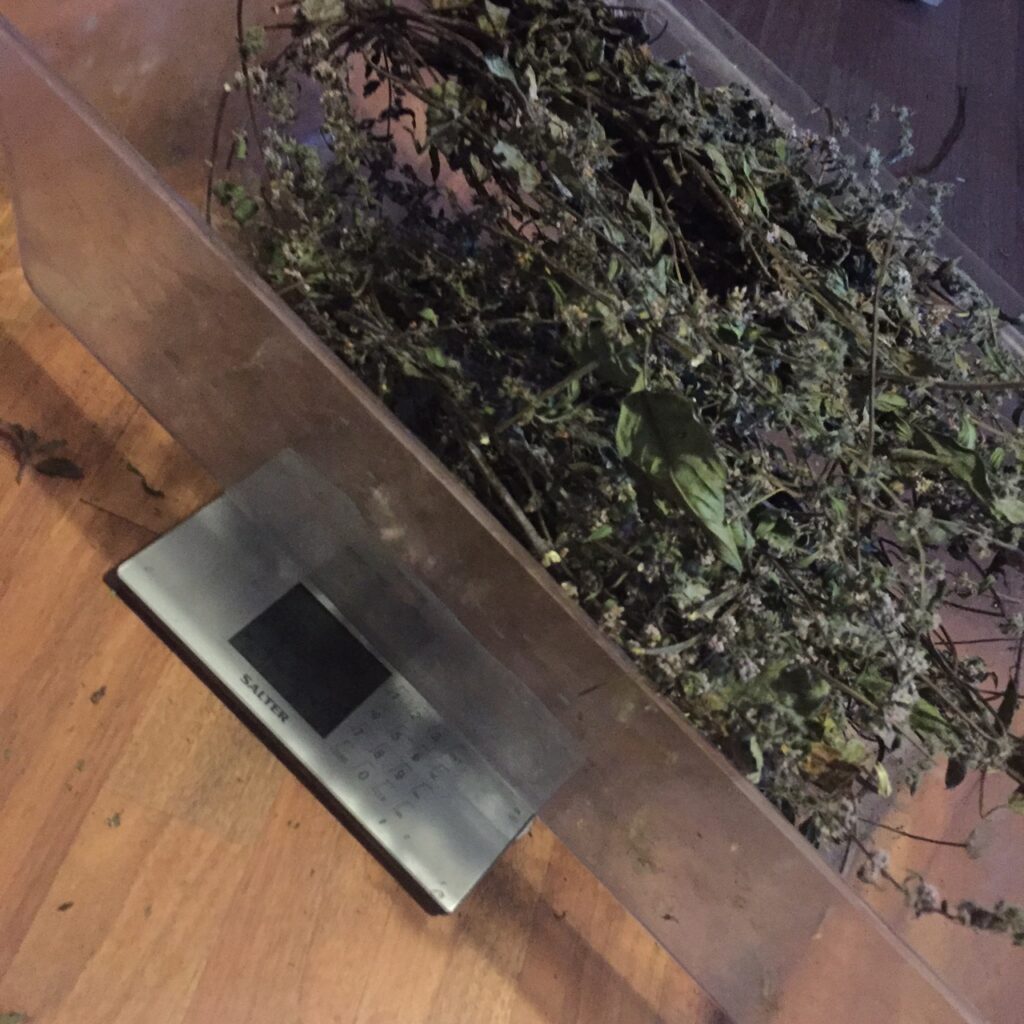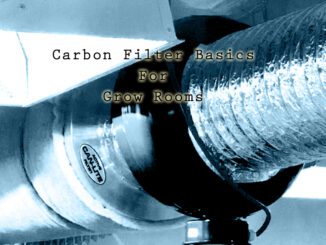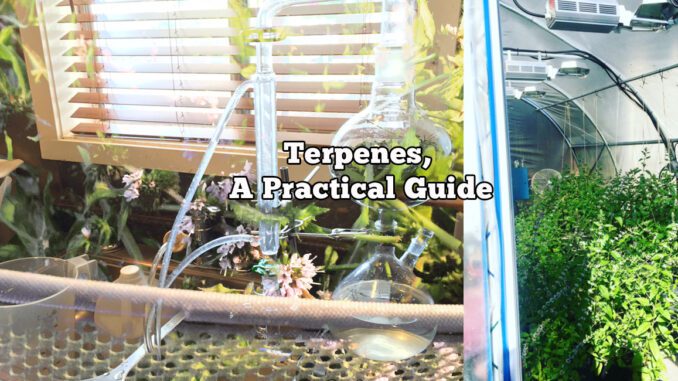
Terpenes
Terps, Terpanoids and Essential Oils Explained (a little)
Terpenes or “Terps” (slang) are a very big part of what gives botanical extracts like essential oils the qualities we may desire, for example what a particular plant extract smells like and what potential therapeutic or medicinal effects they may hold.
Terpenes are occasionally referred to as Terpanoids. Scientifically speaking these are oxygen containing analogues of the terpenes—in case you ever might have wondered.
Above: Extracting pure Spearmint Oil with Steam Distillation
Terpenes are of very high interest and value to industries related to health, beauty, culinary and medicine. These compounds are very widely distributed in the plant kingdom. While some specific terpenes appear in higher contents in some plant varieties over others, no terpene appears to be exclusive to any single type of plant or strain of that species, making them very interesting to researchers from both a production and application perspective.
For most of us, we know the effects of Terpenes through fragrance and flavour, usually in the form of Essential Oils. For example: the peppermint in your toothpaste or the oregano oil you take to help fight colds. An example of a home-type industrial application might be your natural orange cleaner—that powerful stuff that can strip paint off when used undiluted!
Research suggests that most essential oils in common use are comprised of: Monoterpenes, Sesquiterpenes and Diterpenes. While that’s not going to be practical information for most of us, it is interesting to note that the following Classification of Terpenes exists:
Hemiterpenes
Monoterpenes
Sesquiterpenes
Diterpenes
Sesterpenes
Triterpenes
Tetraterpenes
Polyterpenese
How Terpenes Work in Nature
Terpenes, as we know them, give off distinct fragrances, flavours and even effects (ie aromatherapy). Different terpenes may occur in a wide variety of plants, and can be found in a variety of plant parts, ie roots, shoots, leaves, flowers and plant saps.
In nature these compounds help to protect plants from things like plant diseases (ie fungus), insects, and predation from animals. In some cases, it’s an attractant and assists in enlisting pollinators or dispersal of seed (animals eat “tasty” plant and seeds come out as waste at another location).
There are LOTS of different terpenes and they perform a very wide array of functions. The Chart below, is an excellent visualization in understanding just how diverse and vast the world of terpenes is. To See the Original Source, visit here:
https://jameskennedymonash.wordpress.com/2014/01/18/meet-the-terpenes-a-visual-introduction-from-isoprene-to-latex/
NOTE-the visible portion of the chart is not complete and is of lower resolution. DOWNLOAD the Complete 22 MB PDF (Click).
The Value of Terpenes to Growers
If you are growing a crop that derives a large portion of it’s perceived value from the essential oil content it contains, ie culinary, holistic and medicinal herbs you will benefit from having a higher essential oil content in your harvest, with other factors remaining equal (ie yield).
Modern crop nutrient research and resulting formulations may use a variety of ingredients to stimulate higher yields of essential oils (and therefore terpenes). Crop feeding supplements that are engineered to deliver higher yields of essential oils have been proven effective in real world growing situations, increasing essential oil content by near +50% while also increasing fresh and dry crop weights.
For a detailed study, CLICK HERE.
The take away is that you may not need to increase the scale of your growing operation to increase profits when growing terpene producing crops. It can be more efficient to increase your yields of essential oils within your existing crop in some instances.
[ml-adverts location=home-page-content-banner-7]
Extracting Terpenes
For most of us, this means extracting the essential oils from the plant. These extracts are very rich and contain high concentrations of the terpenes produced by the plant, relative to fresh harvested material. The process used for the extraction will influence the ratio of terpenes that may be present, ie some methods may harm one terpene while maximizing the yield of another terpene.
Taken from Grozine Edition TEN, Jordan Gartenhaus offers some good fundamental information on the topic of botanical extractions:
“The method you’ll use to extract essential oils from your crops will depend on:
What it is that you’re looking to concentrate, and how much you’d like to invest in equipment.
For instance, if you’re growing a citrus crop like lemons, oranges, or tangerines, you can simply press the fragrant oils out of the peels (which is often only considered suitable for composting anyway). Using a press as opposed to other methods involving heat will help retain some of the desirable volatile components that would otherwise be lost.
Steeping plant material like dried peppers in organic solvents such as ethanol is another easy way to make extractions. Like making a cup of tea using a tea bag, you can soak the plant material in a vessel of alcohol for several hours and over time any miscible compounds will eventually dissolve. After a few hours you can use a strainer or other filter to separate the liquid from the plant material and then simply let the alcohol evaporate away. The remaining “stuff” you’ll be left with is a mixture of oils, resins, and waxes extracted from the plant.
A common method for extracting less accessible essential oils (Cedarwood oil for instance) is through a steam distiller. A steam distiller forces steam through plant material in order to liberate and subsequently vaporize the oils within. Once the oil becomes a vapor, it clings to the water vapor and is channeled into a collection vessel where the oil and water may be separated (most easily achieved through decanting). This method can be a little more challenging since you’ll need to buy some specialized equipment and because temperature regulation is key. Too much heat can destroy some of the delicate compounds you’re after. But this is a relatively simple, time-tested method for making great extractions, and you can find a plethora of “how-to” guides online.
An extraction method that’s gaining in popularity of late is the supercritical fluid extraction method. We all know that matter most commonly exists in three states depending on the ambient temperature and pressure: Solid, liquid, or gas. Well, it just so happens if you were to keep increasing the temperature and pressure beyond what’s called the “critical-point” (hence the, “super” in “supercritical”) the matter takes on characteristics that are not definitively liquid or gaseous, but a little bit of both. This is advantageous for extractions because now the fluid diffuses through matter like a gas, and dissolves solutes like a liquid solvent would. But unlike liquid organic solvents such as ethanol, supercritical fluids can’t exist at room temperature and pressure. So once the supercritical fluid soaks up all of the essential oils, simply bringing the supercritical fluid back to normal conditions will evaporate all of the remaining extractant, and leave behind only the plant byproducts.
Most often people use carbon dioxide (CO2) for Supercritical fluid extractions. That’s because CO2 is widely available, inexpensive, and is thoroughly non-toxic.
However, this isn’t meant to imply that supercritical extractions are inherently safe either.
Supercritical CO2 requires a tremendous amount of pressure, and if your extraction apparatus is poorly designed or assembled then you risk serious injury. So if you go down this route for extractions make sure you’re building or buying a quality product.
MAKING YOUR OWN QUALITY EXTRACTS CAN BE REALLY REWARDING, IF NOT IMMENSELY ENJOYABLE. YOU CAN ENHANCE OR PUT A FUN TWIST ON YOUR FAVORITE RECIPES, MAKE HOMEMADE MEDICINES, OR DESIGN YOUR OWN FRAGRANCES. THE APPLICATIONS ARE SEEMINGLY ENDLESS, SO GIVE IT A SHOT SOMETIME YOU HAVE A FREE AFTERNOON AND SEE WHAT KIND OF CONCOCTIONS YOU CAN COME UP WITH.”

